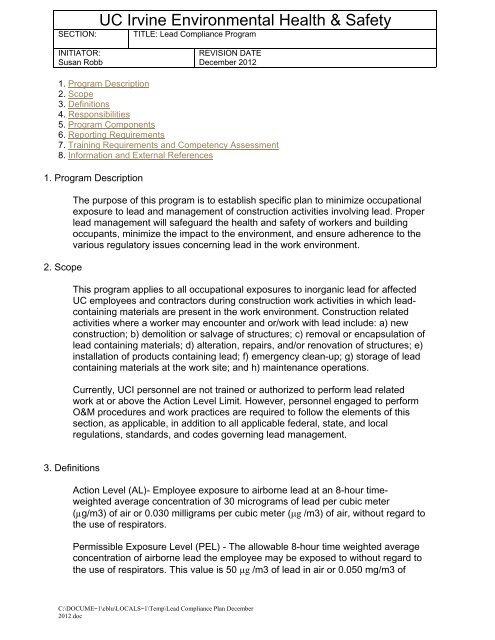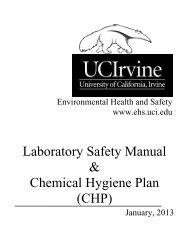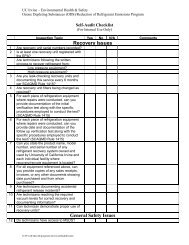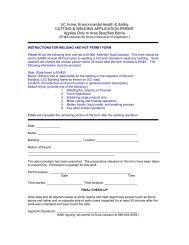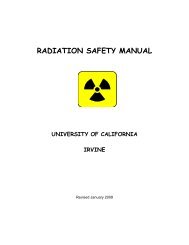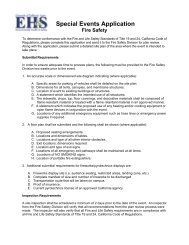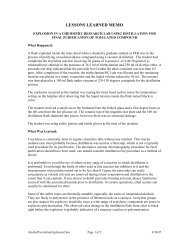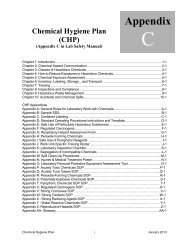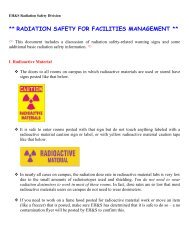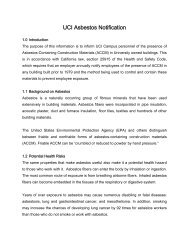Lead Compliance Program - UCI Environmental Health & Safety ...
Lead Compliance Program - UCI Environmental Health & Safety ...
Lead Compliance Program - UCI Environmental Health & Safety ...
Create successful ePaper yourself
Turn your PDF publications into a flip-book with our unique Google optimized e-Paper software.
SECTION:<br />
UC Irvine <strong>Environmental</strong> <strong>Health</strong> & <strong>Safety</strong><br />
TITLE: <strong>Lead</strong> <strong>Compliance</strong> <strong>Program</strong><br />
INITIATOR:<br />
Susan Robb<br />
REVISION DATE<br />
December 2012<br />
1. <strong>Program</strong> Description<br />
2. Scope<br />
3. Definitions<br />
4. Responsibilities<br />
5. <strong>Program</strong> Components<br />
6. Reporting Requirements<br />
7. Training Requirements and Competency Assessment<br />
8. Information and External References<br />
1. <strong>Program</strong> Description<br />
2. Scope<br />
The purpose of this program is to establish specific plan to minimize occupational<br />
exposure to lead and management of construction activities involving lead. Proper<br />
lead management will safeguard the health and safety of workers and building<br />
occupants, minimize the impact to the environment, and ensure adherence to the<br />
various regulatory issues concerning lead in the work environment.<br />
This program applies to all occupational exposures to inorganic lead for affected<br />
UC employees and contractors during construction work activities in which leadcontaining<br />
materials are present in the work environment. Construction related<br />
activities where a worker may encounter and or/work with lead include: a) new<br />
construction; b) demolition or salvage of structures; c) removal or encapsulation of<br />
lead containing materials; d) alteration, repairs, and/or renovation of structures; e)<br />
installation of products containing lead; f) emergency clean-up; g) storage of lead<br />
containing materials at the work site; and h) maintenance operations.<br />
Currently, <strong>UCI</strong> personnel are not trained or authorized to perform lead related<br />
work at or above the Action Level Limit. However, personnel engaged to perform<br />
O&M procedures and work practices are required to follow the elements of this<br />
section, as applicable, in addition to all applicable federal, state, and local<br />
regulations, standards, and codes governing lead management.<br />
3. Definitions<br />
Action Level (AL)- Employee exposure to airborne lead at an 8-hour timeweighted<br />
average concentration of 30 micrograms of lead per cubic meter<br />
(µg/m3) of air or 0.030 milligrams per cubic meter (g /m3) of air, without regard to<br />
the use of respirators.<br />
Permissible Exposure Level (PEL) - The allowable 8-hour time weighted average<br />
concentration of airborne lead the employee may be exposed to without regard to<br />
the use of respirators. This value is 50 g /m3 of lead in air or 0.050 mg/m3 of<br />
C:\DOCUME~1\cblu\LOCALS~1\Temp\<strong>Lead</strong> <strong>Compliance</strong> Plan December<br />
2012.doc
lead in air.<br />
Objective Data- Information from manufacturers or laboratory data that<br />
demonstrates that the use of a material in a specific operation or activity will not<br />
result in exposure to lead at the AL.<br />
Regulated Area-Work areas where airborne exposure to lead is above the PEL.<br />
4. Responsibilities<br />
Industrial Hygienist- Responsibilities include, but are not limited to; overseeing<br />
project-specific lead management programs, inspections of work activities<br />
involving potential lead exposure, lead identification/assessment techniques, and<br />
monitor airborne lead exposures.<br />
<strong>Lead</strong> Employee/Worker- Each employee must have basic knowledge of the<br />
hazards associated with lead. Each employee is responsible for wearing<br />
assigned personal protective equipment, following good personal hygiene<br />
practices, and adhering to all work practices established for each specific job.<br />
Facilities Management Site Supervision- Each supervisor will be responsible for<br />
contacting the Industrial Hygienist to evaluate the presence of lead-containing<br />
materials, controlling access to regulated areas, and ensuring that all work<br />
practices established for a specific job are adhered to by the workers.<br />
Contractor- Each contractor dealing with lead-containing materials are required to<br />
follow by the UC <strong>Environmental</strong> <strong>Health</strong> and <strong>Safety</strong> Department established<br />
guidelines.<br />
5. <strong>Program</strong> Components<br />
5.1 EXPOSURE ASSESSMENT<br />
5.1.1 LEAD IDENTIFICATION BULK SAMPLES<br />
1. Suspect lead-containing materials are evaluated prior to the start<br />
of work. <strong>Lead</strong> analysis must be performed for each unique<br />
surface to be disturbed.<br />
2. For non-residential buildings, a representative number of painted<br />
surface bulk samples should be collected. Two samples should<br />
be collected from each homogeneous surface from each type of<br />
paint/color. One sample may be collected from each type of door<br />
or window frame.<br />
11/2012 2
3. All samples shall be submitted to AIHA and ELLAP accredited<br />
lead laboratories for analysis.<br />
5.1.2 EXPOSURE MONITORING<br />
1. Air monitoring is conducted under the direction of the University’s<br />
Industrial Hygienist.<br />
2. Air samples shall be collected in the breathing zone of<br />
employees where there is potential exposure to lead. Sampling<br />
shall be conducted in accordance with NIOSH Method No. 7082.<br />
3. Where a determination has been made that lead containing<br />
surfaces or materials may be present at the work site, air<br />
monitoring shall be conducted periodically during construction<br />
activities that are representative of the exposure for each job<br />
classification at the work site to represent the initial exposure<br />
assessment.<br />
5.1.3 DETERMINATION OF SURFACE CONTAMINATION LEVELS<br />
To minimize the risk of contamination in eating areas and the<br />
workplace in general, housekeeping measures (HEPA vacuums, wet<br />
mopping, and as listed under Section VII, B), should be<br />
implemented to contain lead dust during any activity involving the<br />
disturbance of lead containing materials. To verify the effectiveness<br />
of housekeeping efforts, the presence of lead contamination on<br />
surfaces shall be conducted using NIOSH 9100 methods.<br />
5.2 CONTROL MEASURES<br />
5.2.1 PERSONAL PROTECTIVE EQUIPMENT<br />
1. Personal Protective Equipment must be worn at all times<br />
where there may be potential exposure to lead containing<br />
materials including the initial exposure assessment phase.<br />
The minimum level of personal protective equipment shall be<br />
specified by the University’s Industrial Hygienist.<br />
2. The appropriate respiratory protection must be worn in<br />
accordance with Appendix B.<br />
3. Respirators must be worn:<br />
a. As an interim protection for tasks until exposure<br />
assessments can be completed, refer to Appendix A<br />
and B to determine the appropriate level of respiratory<br />
protection.<br />
b. When an employee's exposure exceeds the<br />
Permissible Exposure Limit (PEL).<br />
11/2012 3
c. Whenever an employee requests for a respirator.<br />
d. In work situations where engineering and work practice<br />
controls are not sufficient to reduce employee<br />
exposures below the PEL.<br />
4. Coveralls contaminated with lead must not be worn outside of<br />
the regulated area.<br />
5. Gloves should be worn if they do not interfere with the work<br />
being performed.<br />
6. Eye protection meeting the ANSI Z87.1 standard must be<br />
worn during construction activities.<br />
5.2.2 ENGINEERING AND WORK PRACTICE CONTROLS<br />
1. Provide HEPA filtered local exhaust ventilation for devices or<br />
abrasive power tools, needle guns sanders, grinders, and other<br />
equipment that will be used to disturb lead containing surfaces.<br />
2. Use HEPA vacuums for clean up. Do not dry sweep or use<br />
compressed air.<br />
3. Use wet methods to reduce airborne dust generation, e.g., a<br />
water sprayer to hold down settled leaded dust on the plastic<br />
sheeting covering the floor.<br />
4. Wet surfaces with water prior to scraping, sweeping, or sawing.<br />
5. Daily clean up of work area and equipment to prevent leaded<br />
dust accumulations.<br />
6. No eating, drinking, smoking, or applying cosmetics where lead<br />
containing surfaces are being disturbed.<br />
7. Shoveling, wet sweeping, brushing may only be used for cleanup<br />
to pick-up large debris. The debris should be misted with<br />
water prior to clean up to minimize leaded dust generation.<br />
8. All surfaces must be kept as free as practicable from lead<br />
accumulations.<br />
9. Possession or storage or consumption of foods, beverages,<br />
chewing gum, tobacco products, and cosmetic products is<br />
prohibited in the work area.<br />
10. A Regulated Area shall be established around the work location.<br />
In the absence of project-specific exposure data, the Regulated<br />
Area shall be configured to include all areas within a 25-foot<br />
radius of these activities performed on structures with leadcontaining<br />
coatings. The Regulated Areas shall be identified<br />
with warning signs posted at all approaches to the area such that<br />
personnel may read the signs and take necessary protective<br />
steps before entering the area marked by the signs. The signs<br />
shall read as follows:<br />
11/2012 4
WARNING<br />
LEAD WORK AREA<br />
POISON<br />
NO SMOKING OR EATING<br />
11. A change area shall be established at the boundary of the<br />
Regulated Area for the purpose of entry and exit from the<br />
Regulated Area for any purpose except emergencies.<br />
12. Employees entering the Regulated Area will be provided<br />
respiratory protection in accordance with Appendix B.<br />
13. Employees entering the Regulated Area will be provided with<br />
protective work clothing that prevents contamination of the<br />
employee's garments. This protective clothing shall be provided<br />
in a clean and dry condition at least weekly. Protective clothing<br />
shall include, as a minimum:<br />
a. Coverall or similar full-body work clothing<br />
b. Gloves<br />
c. Eye protection<br />
14. Employees exiting the Regulated Area for any purpose shall<br />
decontaminate their protective clothing by the following methods:<br />
a. Removal of outer protective clothing<br />
b. Use of a HEPA-filtered vacuum<br />
15. Provisions shall be made in the change area for the collection of<br />
contaminated items such as work clothing, respirator cartridges,<br />
and equipment.<br />
16. Provisions will be made for employees to wash their hands and<br />
face at the completion of the activity and/or before departing from<br />
work at the end of the shift. Also, provisions will be made to<br />
allow employees to wash their hands and face prior to eating,<br />
drinking, smoking, or applying cosmetics.<br />
17. Shower facilities should be provided when deemed appropriate<br />
by the Industrial Hygienist. This decision shall be made upon<br />
consideration of project duration and location, climate, and<br />
availability of acceptable water supply.<br />
5.3 MEDICAL SURVEILLANCE<br />
5.3.1 INITIAL MEDICAL SURVEILLANCE<br />
Employees exposed on any day to airborne lead concentrations at<br />
or above 30 g /m3 will have the opportunity to receive a baseline<br />
blood lead level (BLL) examination. This examination shall include<br />
the BLL and the zinc protoporphyrin level. Medical examinations<br />
and information provided to examining and consulting physicians<br />
shall be in accordance with Cal/OSHA Standard Section 1532.1 and<br />
11/2012 5
under the direction of an Occupational Physician designated by UC<br />
EH&S. The following information shall be provided to the consulting<br />
physicians:<br />
a. Copy of Cal/OSHA’s <strong>Lead</strong> in Construction Standard, Title<br />
8 Section 1532.1, including all Appendices.<br />
b. Description of the affected employee's duties as they<br />
relate to the employee's exposure.<br />
c. Employee's exposure level or anticipated exposure level<br />
to lead and to any other toxic substance (if applicable).<br />
d. Description of any personal protective equipment used or<br />
to be used.<br />
e. Prior blood lead determinations.<br />
f. All prior written medical opinions concerning the employee<br />
in the employer's possession or control.<br />
5.3.2 MEDICAL CONSULTATION<br />
Medical consultation will be made available at least annually to any<br />
employee under the following situations:<br />
a. The employee has a confirmed BLL of 40 g /dL or higher<br />
within the preceding 12 months.<br />
b. The employee exhibits signs or symptoms commonly<br />
associated with lead intoxication.<br />
c. The employee desires medical advice concerning the<br />
effects of current or past exposure to lead on the<br />
employee's ability to procreate a healthy child.<br />
5.3.3 MULTIPLE PHYSICIAN REVIEW<br />
UC will select the physician to conduct the initial medical<br />
examination, as listed under Title 8, Section 1532.1. The employee<br />
has the right to designate a second physician to review initial<br />
examination results after notification to the UC Worker's<br />
Compensation Office, and have a second examination conducted<br />
only after the initial medical examination has been completed. In the<br />
event the two physicians differ in their findings, a third party<br />
physician will be agreed on by the two physicians to resolve prior<br />
disagreements.<br />
5.3.4 MEDICAL REMOVAL PROTECTION<br />
Medical removal protection (MRP) involves the temporary removal<br />
of an employee from a worksite, due to elevated blood lead levels,<br />
to a place of significantly lower exposure without loss of earnings or<br />
seniority or other employment rights or benefits.<br />
11/2012 6
5.4 RECORDKEEPING<br />
An employee is included in the MRP when:<br />
a. Worker's periodic and follow-up BLL are equal to 50<br />
micrograms per deciliter (g/dL). The employee can return<br />
to the worksite when two consecutive BLL are less than<br />
40 (g/dL).<br />
b. A final medical determination indicates a medical<br />
condition that places the employee at "increased risk of<br />
material impairment to health" due to lead exposure.<br />
An employee removed as a result of the physician's<br />
recommendation may be returned to former job status when the<br />
physician indicates it is safe to do so.<br />
Accurate records will be established and maintained for the following subjects. The<br />
record retention period will be in accordance with UC record retention guidelines.<br />
Affected employees, former employees, and their designated representatives can<br />
obtain access to the records mentioned above by providing a written request to the<br />
Occupational <strong>Health</strong> Nurse in the <strong>Environmental</strong> <strong>Health</strong> and <strong>Safety</strong> Office.<br />
1. EXPOSURE ASSESSMENT<br />
11/2012 7<br />
All employee monitoring data will be retained for the period of<br />
employment plus 30 years. Exposure monitoring records<br />
shall include:<br />
a. Date(s), number, duration, location and results of<br />
each of the samples taken if any, including a<br />
description of the sampling procedure used to<br />
determine representative employee exposure<br />
where applicable<br />
b. Description of the sampling and analytical<br />
methods used and evidence of their accuracy<br />
c. Type of respiratory protective devices worn, if any<br />
d. Name, social security number, and job<br />
classification of employee monitored and all other<br />
employees whose exposure the measurement is<br />
intended to represent<br />
e. <strong>Environmental</strong> variables that could affect the<br />
measurement of employee exposure<br />
2. MEDICAL SURVEILLANCE<br />
Records will be maintained for employees subject to medical
surveillance. Records will include at a minimum:<br />
Employee name<br />
Social security number<br />
Job description/duties<br />
Air monitoring data pertinent to the<br />
employee<br />
Any employee medical complaints<br />
Medical examination results including<br />
medical/work history<br />
Biological monitoring<br />
Any information or guidelines used to<br />
interpret laboratory tests.<br />
Medical records appropriate to this section will be retained<br />
for a period of employment plus 30 years.<br />
3. MEDICAL REMOVAL<br />
Records will be maintained for employees removed from<br />
current job status due to elevated BLLs. Records will include<br />
at a minimum: employee name; social security number; date<br />
of removal and return to job status; explanation of how the<br />
removal was accomplished; and reason for removal. Records<br />
will be retained for a least the duration of the employee's<br />
employment.<br />
4. TRAINING<br />
EH&S Office will maintain training records on each employee<br />
trained under this <strong>Lead</strong> <strong>Compliance</strong> <strong>Program</strong>. Records will<br />
include: date of training; employee name; and a description or<br />
outline of training content.<br />
5.5 ENVIRONMENTAL MANAGEMENT<br />
<strong>Environmental</strong> management (i.e., waste characterization, waste disposal) will be<br />
conducted under the direction of the Hazardous Waste Section of <strong>Environmental</strong><br />
<strong>Health</strong> and <strong>Safety</strong>.<br />
The “Guidance on Waste Management for <strong>Lead</strong> Abatement Activities” is in<br />
Appendix E of this document.<br />
11/2012 8
6. Reporting Requirements<br />
All work shall be performed in strict accordance with all applicable federal, state,<br />
and local regulations, standards, and codes governing lead, and any other trade<br />
work done in conjunction with the disturbance of lead. The lead contractor<br />
generally makes notification to regulatory agencies. The <strong>Lead</strong> <strong>Program</strong><br />
Coordinator facilitates notification to affected <strong>UCI</strong> personnel.<br />
The most recent editions of any relevant regulation, standard, document, or code<br />
shall be in effect. Where conflict among the requirements or with these<br />
specifications exists, the most stringent requirements shall apply.<br />
Any work involving disturbance of lead shall comply with the requirements of the<br />
California General Industry <strong>Safety</strong> and <strong>Health</strong> Standards, and the <strong>Safety</strong> and<br />
<strong>Health</strong> Regulations for Construction, Title 8, California Code of Regulations<br />
(CCR), including, but not limited to the following sections:<br />
Section 5144:<br />
Respiratory Protection<br />
Section 2405.4:<br />
Electrical<br />
Section 1637, 1640, 1658:<br />
Scaffolding<br />
Section 1513:<br />
Housekeeping<br />
Section 5194:<br />
Hazard Communication<br />
Section 1675:<br />
Ladders<br />
Section 3215 and 3220:<br />
Egress and Emergency Plans<br />
Section 1514:<br />
Personal Protective Equipment<br />
Section 1519: Sanitation Section 3360:<br />
Sanitation<br />
Section 1684, 3555, and 3556: Powered Hand Tools<br />
Section 1502:<br />
Contractors Responsibilities<br />
Section 1511:<br />
General <strong>Safety</strong> and <strong>Health</strong><br />
Provisions<br />
Section 1510<br />
<strong>Safety</strong> Training and Education<br />
Section 1527 and 3366:<br />
Washing Facilities<br />
Section 1528:<br />
Gases, Vapors, Fumes, Dusts,<br />
and Mists<br />
Section 1531 and 5143:<br />
Ventilation<br />
Section 3203:<br />
Injury and Illness Prevention<br />
<strong>Program</strong><br />
Section 3204:<br />
Access to Employee's Exposure<br />
and Medical Records<br />
Section 6003:<br />
Accident Prevention Signs<br />
Section 3221:<br />
Fire Prevention Plan<br />
Section 1532.1:<br />
Construction <strong>Safety</strong> Orders, <strong>Lead</strong><br />
11/2012 9
Any work involving disturbance of lead shall comply with the Federal <strong>Environmental</strong><br />
Protection Regulations pertaining to the handling and disposal of lead-containing<br />
materials, as well as the State of California and any local government agencies<br />
which have delegated responsibility for the administration and enforcement of<br />
federal regulations.<br />
22 CCR, Section 66261<br />
10 CFR, Part 261<br />
The Contractor shall comply with all requirements of the EPA-approved landfill that is<br />
selected as the disposal site.<br />
The contractor shall comply with California Title17, Section 8.<br />
7. Competency Assessment and Training Requirements<br />
Employee General Awareness<br />
For each employee in a work environment where lead-containing materials are<br />
present, training will be conducted initially upon job assignment. Training will consist<br />
of, as a minimum, an overview of the hazards of lead; warning signs/labels; relevant<br />
information from an MSDS; and the contents of the <strong>Lead</strong> <strong>Compliance</strong> <strong>Program</strong>.<br />
<strong>Lead</strong> Worker Training<br />
In addition to general awareness training, each worker exposed to an airborne<br />
concentration of lead above the action level of 30 g /m3 (micrograms per cubic<br />
meter) shall receive at least annually information concerning:<br />
1. Specific jobs that could result in an exposure above the action level<br />
2. General respirator and use of personal protective equipment<br />
3. Proper use of engineering controls and work practice controls<br />
4. Medical surveillance/removal program<br />
5. Use of chelating agents<br />
6. Access to medical/exposure records/training materials<br />
7. Content of Cal/OSHA’s <strong>Lead</strong> in Construction Standard, Title 8 Section<br />
1532.1.<br />
Respiratory Protection Training<br />
All UC employees required to use a respirator must participate in the UC Respiratory<br />
Protection <strong>Program</strong>.<br />
11/2012 10
8. Information and External References<br />
<strong>Lead</strong> Regulations- Title 8 CCR 1532.1; Title 29 CFR 1910.1025; Title 29 CFR<br />
1926.62, 40 CFR part 745 (I), (B), Title 17 CCR Division 1 Chapter 8 <strong>Lead</strong>-Based<br />
Paint and <strong>Lead</strong> Hazards<br />
The original of all documents pertaining to this <strong>Lead</strong> <strong>Compliance</strong> Plan will be kept<br />
on file at EH&S. The standard documents to be kept on file will be:<br />
Reports of Survey and Laboratory Analyses - Original<br />
Records of Areas Removed/Abated<br />
Disposal Records Verification<br />
Summary of <strong>Lead</strong> Containing Materials on Campus - Consult with EH&S for the<br />
most updated list.<br />
11/2012 11
APPENDIX A<br />
ASSUMED EXPOSURES FOR CONSTRUCTION TASKS*<br />
50 g/m 3 to 500 g/m 3 500 g/m 3 to 2500 g/m 3 Greater than 2500 g/m 3<br />
Manual demolition<br />
Manual scraping<br />
Manual sanding<br />
Heat gun use<br />
Power tool paint removal in<br />
the HEPA vacuum-assist dust<br />
collection system<br />
Cleanup on dry, abrasive<br />
blasting jobs<br />
Abrasive blasting enclosure<br />
movement/removal<br />
Abrasive blasting<br />
*Title 8 CCR, Section 1532.1<br />
11/2012 12
APPENDIX B<br />
RESPIRATORY PROTECTION FOR LEAD AEROSOLS<br />
Airborne Concentration of <strong>Lead</strong><br />
or Condition of Use<br />
Required Respirator<br />
Not in excess of 500 g/m 3 ½ mask air purifying respirator with high efficiency filters<br />
<br />
½ mask supplied air respirator operated in demand (negative<br />
pressure) mode<br />
Not in excess of 1250 g/m 3 Loose fitting hood or helmet powered air purifying respirator<br />
with high efficiency filters<br />
<br />
Hood or helmet supplied air respirator operated in a continuousflow<br />
mode, e.g., type CE abrasive blasting respirator<br />
operated in a continuous-flow mode<br />
Not in excess of 2500 g/m 3<br />
Full facepiece air purifying respirator with high efficiency<br />
filters<br />
<br />
<br />
<br />
<br />
Tight fitting powered air purifying respirator with high<br />
efficiency filters<br />
Full facepiece supplied air respirator operated in a continuousflow<br />
mode<br />
½ mask of full facepiece supplied air respirator operated in<br />
demand mode<br />
Full facepiece self-contained breathing apparatus (SCBA)<br />
operated in demand mode<br />
Not in excess of 50,000 g/m 3 ½ mask supplied air respirator operated in pressure demand or<br />
other positive-pressure mode<br />
Not in excess of 100,000 g/m 3<br />
Full facepiece supplied air respirator operated in pressure<br />
demand or other positive-pressure mode, e.g., type CE<br />
abrasive blasting respirators operated in a positive-pressure<br />
mode<br />
Greater than 100,000 g/m 3<br />
unknown concentration, or fire fighting<br />
<br />
Full facepiece SCBA operated in pressure demand or other<br />
positive-pressure mode<br />
11/2012 13
APPENDIX C<br />
EXPOSURE CONTROL STRATEGY DURING RENOVATION/PAINTING/SANDING<br />
OPERATIONS OF SURFACES CONTAINING 600 PPM LEAD OR GREATER<br />
1.00 GENERAL<br />
Contractor shall take measures to prevent contamination of indoor surfaces, the<br />
environment, and personnel.<br />
2.00 REQUIREMENTS<br />
2.01 Cal/OSHA regulates lead exposure and has assigned a Permissible Exposure Limit<br />
of 50 micrograms per cubic meter. At a minimum contractor will follow the <strong>Lead</strong> in<br />
Construction safety orders as specified under Cal/OSHA regulation Title 8, Section<br />
1532.1.<br />
2.02 The building shall remain unoccupied during renovation activities. The area shall be<br />
secured with barrier tapes to prevent unauthorized personnel from entering the work<br />
areas.<br />
2.03 All HVAC systems must be turned off prior to commencement of sanding activities.<br />
Cover the air vents with plastic after turning off the system.<br />
2.04 Carpets and all furniture should be removed prior to sanding activities.<br />
2.05 Only vacuum cleaners equipped with HEPA filters should be used to clean-up<br />
interior dusts.<br />
2.06 A layer of 6-mil polyethylene sheeting shall be laid over the entire floor.<br />
2.07 All windows should be kept closed to prevent dust and chips from leaving the area.<br />
2.08 Dry sanding is not allowed.<br />
2.10 Wet Scraping<br />
2.11 A scraper attached to a HEPA vacuum is recommended for the scraping process.<br />
2.12 Wet scraping can also be done by misting the surface with water to minimize dust<br />
generation. A scraper can be used to remove loose chips of paint.<br />
2.13 Use a damp rag to collect large chips that fall on to the 6-mil plastic floor<br />
containment.<br />
11/2012 14
2.14 HEPA vacuum paint dusts on the plastic sheeting.<br />
2.20 Wet Sanding<br />
2.21 Traditional orbiting sanding devices may be used only in conjunction with a HEPA vacuum filter<br />
attachment.<br />
2.22 Wood, metal, and painted surfaces that require a fine cosmetic finish may be sanded using wet/dry<br />
sand paper and water or an oil paint solvent.<br />
2.23 Relatively rough surfaces may be finished using wet foam sanding blocks created by dipping a<br />
sponge in an aluminum oxide grit. These sponge sanders are ideally suited for wet sanding and can<br />
be easily cleaned by immersing in a bucket of 5 -6% trisodium phosphate (TSP).<br />
2.30 Surface Cleaning<br />
2.31 HEPA vacuum all surfaces (sanded walls, windows, and floors); follow by surface wipe cleaning<br />
with a 5-6% TSP solution and rinse with water. A two-bucket system should be used: one for the<br />
cleaning solution and the other for rinsing using a new sponge. Change the wash water at least once<br />
in each room.<br />
2.32 Begin at the top of each room and work down.<br />
2.34 When vacuuming, use a crevice and brush tool where appropriate.<br />
2.35 HEPA vacuum the polyethylene sheeting prior to removal.<br />
2.36 Remove and dispose of HEPA vacuum cleaner bags outside of the building.<br />
2.37 Repaint surfaces with paint free of lead, mercury, and other heavy metals.<br />
2.38 Contact EH&S for final clearance. Surface wipe samples of floors and windows will be collected to<br />
ensure surfaces do not have excessive lead residues. Clearance levels set by EPA/Housing and<br />
Urban Development Guidelines will be followed.<br />
2.40 Waste Disposal<br />
2.41 All HEPA filters must be disposed of as required by EH&S Hazardous Waste Department.<br />
2.42 The contractor must obtain prior approval from EH&S Hazardous Waste Department on any<br />
proposed TSDF.<br />
15
APPENDIX D<br />
EXPOSURE CONTROL STRATEGY DURING DEMOLITION/SANDING/PAINTING<br />
of SURFACES CONTAINING LESS THAN 600 PPM LEAD<br />
1.00 GENERAL<br />
Contractor shall take measures to prevent contamination of indoor surfaces, the environment, and<br />
personnel. All painted surfaces contain lead.<br />
2.00 REQUIREMENTS<br />
2.01 Cal/OSHA regulates lead exposure and has assigned a Permissible Exposure Limit of 50<br />
micrograms per cubic meter. At a minimum contractor will follow the <strong>Lead</strong> in Construction <strong>Safety</strong><br />
Orders as specified under Cal/OSHA regulation Title 8, Section 1532.1.<br />
2.02 At a minimum, the area under renovation shall remain unoccupied during renovation activities. The<br />
area shall be secured with barrier tapes to prevent unauthorized personnel from entering the work<br />
areas.<br />
2.03 All HVAC systems must be turned off prior to commencement of sanding activities or demolition<br />
activities. Install critical barriers by covering the air vents and door openings with plastic after<br />
turning off the HVAC system.<br />
2.04 Building surfaces to be demolished should be wetted down with water to minimize the dispersal of<br />
paint dust. Surfaces should be substantially wet so that there are no visible dust dispersed in the air.<br />
2.05 EH&S must be contacted for perimeter air monitoring.<br />
16
APPENDIX E<br />
GUIDANCE ON WASTE MANAGEMENT FOR LEAD ABATEMENT ACTIVITIES<br />
Wastes generated from lead abatement, or any of the activities listed above, may be regulated by the Department of<br />
Toxic Substances Control (Department) because they contain lead, a toxic substance. Wastes from the use of<br />
chemical paint strippers may also be corrosive. A corrosive waste has a pH 12.5, or it corrodes steel at a<br />
rate greater than 6.35 mm per year. 1<br />
In California, there are two regulatory levels for wastes contaminated with lead, the Total Threshold Limit<br />
Concentration (TTLC) and the Soluble Threshold Limit Concentration (STLC). The regulatory limits for lead are<br />
1000 mg/kg and 5.0 mg/L, respectively. 2 In addition, federal law (Resource Conservation and Recovery Act or<br />
RCRA) regulates lead by establishing a maximum concentration of 5 mg/L. Although this level is the same as<br />
California’s STLC, federal law specifies a different testing procedure. 3<br />
Some wastes that may be generated by lead removal and clean-up activities include paint chips, dust, chemical<br />
stripper sludge, waste water, rags, sponges, filters, and large debris such as doors, casements, jams, and moldings.<br />
EH&S recommends that lead paint wastes be segregated into the following categories to aid in classifying the wastes<br />
as hazardous or nonhazardous. Depending on the quantities of wastes generated, it may be economical to dispose of<br />
all wastes in category A as hazardous without testing. According to U.S. EPA tests, 4 wastes in category B are less<br />
likely to be hazardous wastes, and thus they should be tested for proper classification. Solid components coated<br />
with intact, unpeeling paint may test as hazardous if the paint has a high lead content; plastic sheeting may test as<br />
hazardous if a heat gun was used to remove paint. 5 Segregating Category A wastes from Category B wastes may<br />
result in a reduction in the volume of hazardous waste generated.<br />
Table 1<br />
CATEGORY A: WASTE USUALLY FOUND TO BE HAZARDOUS<br />
<br />
<br />
<br />
<br />
Paint chips and dust from vacuum debris and dust<br />
Waste wash water<br />
Sludge from chemical stripping<br />
Rags, sponges, mops, HEPA filters, scrapers, and other materials used for testing, abatement and clean-up<br />
Table 2<br />
CATEGORY B: WASTES THAT MAY BE HAZARDOUS<br />
<br />
<br />
<br />
<br />
Disposable work clothing<br />
Respirator filters<br />
Polyethylene (plastic) sheeting<br />
Solid components coated with intact, unpeeling paint, such as doors, casements, molding, and jams<br />
1<br />
Title 22, California Code of Regulations (22 CCR), § 66261.22.<br />
2<br />
22 CCR, § 66261.24 (a)(2) and Table II.<br />
3<br />
see 22 CCR §66261.24 (a)(1) and Table I.<br />
4<br />
U.S. EPA. 1993. Applicability of RCRA disposal requirements to lead-based paint abatement wastes. Final<br />
Report. Technical <strong>Program</strong>s Branch, Office of Pollution Prevention and Toxics. March 1993<br />
5 Ibid<br />
*Excerpt from California <strong>Environmental</strong> Protection Agency, Department of Toxic Substances<br />
Control<br />
17
RCRA Wastes<br />
<strong>Lead</strong> wastes are RCRA wastes if, when tested by the Toxicity Characteristic Leaching Procedure (TCLP),<br />
the lead content equals or exceeds 5.0 mg/L. 6 While this is the same regulatory level as California's<br />
STLC, the TCLP test extracts less lead from a sample than does California's test. The EPA hazardous<br />
waste number for lead is D008. D008 wastes are subject to Land Disposal Restrictions (LDR), and must<br />
meet the treatment standard of 5.0 mg/L or less extractable lead before disposal. 7<br />
California-only hazardous wastes<br />
If the lead content of a sample of waste is less than 5.0 mg/L using the TCLP, but is greater than or equals<br />
the TTLC or STLC (applying the Waste Extraction Test, or WET), then the waste is a California-only<br />
hazardous waste, also known as a non-RCRA waste. The compliance date for these metal-containing solid<br />
wastes to be treated to the standards has been extended to January 1, 1996. 8<br />
Debris<br />
Hazardous debris is defined as 9 :<br />
• Solid discarded material exceeding a 60 mm (2.5 in) particle size intended for disposal;<br />
• a manufactured object; or plant or animal matter; or natural geologic material. Debris does not include<br />
those materials for which there is a specific treatment standard (e.g., lead-acid batteries).<br />
Hazardous debris, such as doors and moldings, is subject to LDR and must be treated prior to land<br />
disposal using extraction, destruction, or immobilization technologies, which are defined in Table 1 of 22<br />
CCR § 66268.45. Hazardous debris that is treated using one of the specified extraction or destruction<br />
technologies of Table 1 and that no longer exhibits a characteristic of hazardous wastes after treatment is<br />
not a hazardous waste and need not be managed in a permitted hazardous waste landfill. Residuals from<br />
the treatment (e.g., lead paint) must be separated from the treated debris and managed as hazardous<br />
waste. l0<br />
6<br />
See 22 CCR § 66261.24 (a)(1).<br />
7<br />
See 22 CCR § 66268.40 Treatment Standards for Hazardous Waste.<br />
8<br />
Senate Bill 1574, amendments HSC § 25719.7<br />
9<br />
22 CCR § 66261.10. Definitions.<br />
10<br />
22 CCR § 66268.7(d) and 66268.45.<br />
18
CHARACTERIZATION OF LEAD WASTE<br />
Will you be generating hazardous waste?<br />
Segregate components<br />
Draw representative samples<br />
TTLC<br />
Total Threshold Limit Concentration<br />
Less than 1000 mg/kg<br />
1000 mg/kg or more?<br />
(Hazardous Class I)<br />
Less than 50 mg/kg?<br />
Not Hazardous:<br />
Cannot fail W.E.T. test<br />
50 mg/kg or more?<br />
W.E.T.<br />
Soluble Threshold Limit Concentration<br />
Less than 5 mg/L?<br />
5 mg/L or more?<br />
Not Hazardous: (Hazardous Class I)<br />
Stop testing<br />
You now have a hazardous waste in California...<br />
Comply with Federal testing requirements<br />
TCLP<br />
Toxicity Characteristic Leaching Procedure<br />
(Federal test for soluble metal)<br />
Less than 5 mg/L?<br />
Treatment not required<br />
5 mg/L or more?<br />
Dispose of as Hazardous Waste<br />
19
UNIVERSITY OF CALIFORNIA, IRVINE<br />
APPENDIX F<br />
BERKELEY DAVIS IRVINE LOS ANGELES MERCED RIVERSIDE SAN DIEGO SAN FRANCISCO<br />
SANTA BARBARA SANTA CRUZ<br />
ENVIRONMENTAL HEALTH AND SAFETY<br />
4600 HEALTH SCIENCES ROAD<br />
IRVINE, CALIFORNIA 92697-2725<br />
FAX NUMBER: (949) 824-9180<br />
UC Irvine Construction Related Hazardous Waste<br />
Scope<br />
Some construction related wastes are hazardous and require special handling. Examples of such wastes<br />
include:<br />
Asbestos Containing Materials Mercury Containing Lamps<br />
Contaminated Soil Motor Oil<br />
Contaminated Piping Paint Related Materials<br />
Hydraulic Oil PCB Containing Caulking<br />
<strong>Lead</strong>-Containing Materials PCB Containing Transformers<br />
Mercury Switches PCB and Non-PCB Lamp Ballasts<br />
Radioactive Tritium Exit Signs<br />
Incorrect documentation, transportation, tracking and disposal of hazardous wastes can result in costly<br />
violations.<br />
Controls<br />
EH&S has a list of University of California Office of the President (UCOP) approved hazardous waste<br />
disposal facilities. EH&S will provide a qualified person to inspect the shipment for compliance and sign<br />
the hazardous waste manifest.<br />
Process<br />
1. When a construction project will generate hazardous wastes, the project manager must ensure<br />
the bidding contractor contact EH&S and provide the following information:<br />
Transporter Qualifications<br />
Hazardous Waste Hauler’s licenses and permits.<br />
Insurance Requirements<br />
Comprehensive or Commercial Form General Liability Insurance.<br />
Business Automobile Liability Insurance for owned, scheduled, non-owned, or hired vehicles.<br />
Hazardous Waste<br />
A list of the amount and type of hazardous waste that will be generated and disposed.<br />
2. EH&S will provide the bidding contractor a list of approved treatment, storage, and disposal<br />
facilities (TSDF) that the bidding contractor must use. The approved TSDF will vary depending<br />
on the type of waste.<br />
3. When the hazardous waste is ready for shipment, the project manager or the transporter must<br />
contact EH&S to sign all hazardous waste manifests. Please provide 48 hours advance notice for<br />
a hazardous waste manifest signature.<br />
<strong>Environmental</strong> <strong>Health</strong> and <strong>Safety</strong> September 14, 2012 Version 2.4
EH&S Contact Information and Additional Requirements<br />
Primary Contact:<br />
Ricardo Cruz<br />
Hazardous Waste Operations Specialist<br />
<strong>Environmental</strong> <strong>Health</strong> and <strong>Safety</strong><br />
University of California, Irvine<br />
4600 <strong>Health</strong> Sciences Road<br />
Irvine, CA 92697-2725<br />
949-824-2811 office<br />
949-824-9180 fax<br />
rccruz@uci.edu<br />
Alternate Contact:<br />
Kirk Matin<br />
Manager, <strong>Environmental</strong> / Hazardous Waste<br />
<strong>Environmental</strong> <strong>Health</strong> and <strong>Safety</strong><br />
University of California, Irvine<br />
4600 <strong>Health</strong> Sciences Road<br />
Irvine, CA 92697-2725<br />
949-824-4578 office<br />
949-824-9180 fax<br />
kmatin@uci.edu<br />
Storage of Waste<br />
All waste must be in a secured and locked area not accessible to the general public.<br />
All waste must be appropriately labeled.<br />
Manifests<br />
<br />
All manifests must have the following “Generator’s Name and Mailing Address”:<br />
University of California, Irvine – EH&S<br />
4600 <strong>Health</strong> Sciences Rd.<br />
Irvine, CA 92697-2725<br />
Attn: Kirk Matin<br />
(949) 824-4578<br />
Treatment Storage and Disposal Facility (TSDF)<br />
All hazardous and non-hazardous asbestos waste must be manifested to:<br />
Azusa Land Reclamation Or Chemical Waste Management Kettleman Hills<br />
1201 West Gladstone Street 35251 Old Skyline Road<br />
Azusa, CA 91702 Kettleman City, CA 93239<br />
<br />
For all other hazardous waste, please contact EH&S.<br />
EPA ID Number<br />
Non-Hazardous Waste Manifests DO NOT require an EPA ID Number.<br />
For Uniform Hazardous Waste Manifest, please use CAT000625293.<br />
See attached Friable Asbestos Manifest and Label Examples<br />
Transporter Identification<br />
All drivers must carry employee identification and proof of vehicle insurance.<br />
Waste Pickup Location<br />
Drivers must know the waste pickup location(s). Contact the <strong>UCI</strong> Project Manager to arrange<br />
for access to the location(s).<br />
Manifest Signatures<br />
An <strong>Environmental</strong> <strong>Health</strong> and <strong>Safety</strong> Hazardous Waste Staff Member must sign all<br />
hazardous and non-hazardous waste manifests. Please provide 48 hours advance notice for<br />
a hazardous waste manifest signature.<br />
Please contact Kirk Matin at (949) 824-4578 if you have any questions.


